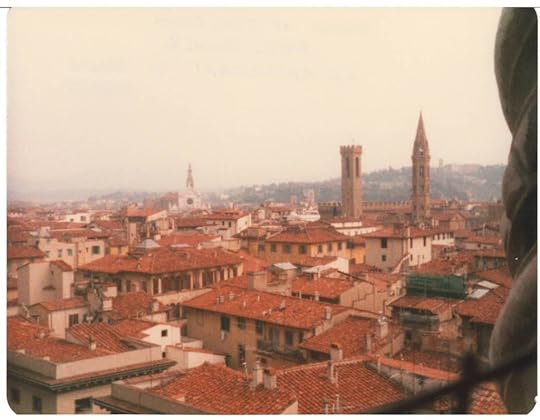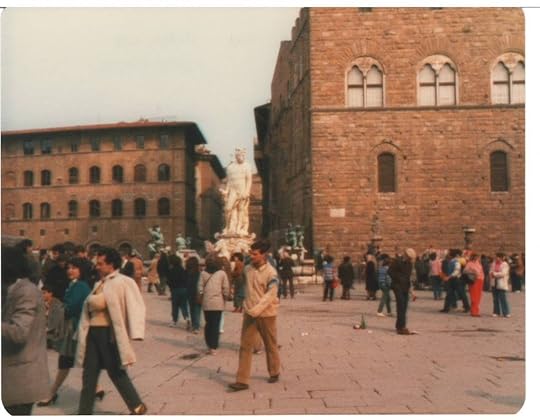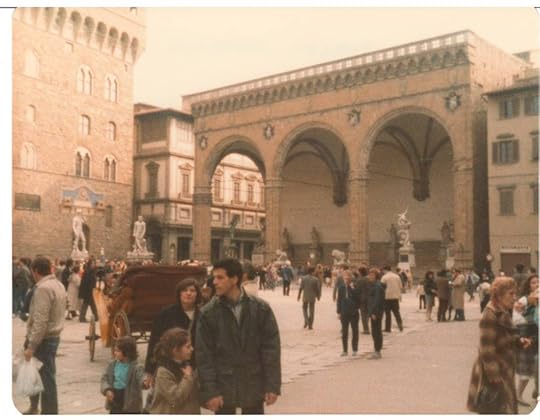“While reading Mary McCarthy’s The Stones of Florence”
For today’s blog post, I have the great pleasure of introducing a poem by Sandra Barry. You might remember her beautiful poem “Old Rusty Metal Things,” which I shared here last April, and the wonderful photos taken by her sister Brenda Barry, which I’ve included in several blog posts over the past year or so. I asked Sandra recently if she’d like to share another poem with all of you, and I was delighted when she said yes and sent me “While reading Mary McCarthy’s The Stones of Florence.”
This poem was inspired by Sandra’s trip to France and Italy in April of 1984, almost forty years ago, with her sisters Donna and Brenda and friend Pam. She writes, “That brief visit to Florence was memorable, but it had left my active thoughts for years until I found a used copy of Mary McCarthy’s The Stones of Florence in some used bookstore—I am not much of a fan of her fiction (she wrote an infamous novel, The Group, about Vassar, with one character supposedly based on Elizabeth Bishop—I couldn’t get past page 5 of it). But I like her non-fiction, which I find much more lively. Anyway, I read the Florence book quickly and it triggered a flood of long forgotten memory—quite the experience—and I immediately went looking for the photos from that trip and found that they reflected most of the vivid memories I had retained. Travel was so important to Bishop—and she did visit Italy at least once during her life—though it was Rome that impressed her most.”

Sandra says, “The photos were taken by Donna with a tiny film camera she had—might have even been one of those disposable jobs. They are quite poor quality, but there is something about their vagueness and distance that actually works with the poem, which is a memory poem.”
Sandra is a freelance editor and an Elizabeth Bishop scholar, and her book Elizabeth Bishop: Nova Scotia’s “Home-Made” Poet, was published by Nimbus in 2011. You can read more about both Sandra and Bishop in the introduction to “Old Rusty Metal Things.”
(I wish I could show the poem single-spaced, but for some reason, WordPress won’t let me change the format.)

While reading Mary McCarthy’s The Stones of Florence
Casting my mind back to my own brief encounter
—an afternoon overwhelmed by noise and stone;
the milky sunshine, the vague sky contrasting
the perpendicular,
the narrow straight up streets and a short expensive
carriage ride. Two photographs. One: a vanishing point
from the seat of the carriage, the claustrophobic height
of heavy stone receding to where my memory resides.
I do not remember the soft brown horse, the pale green
tweed of the driver. I do remember a glimpse
of stunning black eyes among thousands.
Two: the soft brown horse freed of his tourist haul
feeding from a bag of oats hung on his harness,
his flanks and back covered by a blanket
to keep the April chill away.
The narrow streets have opened into a square
walled by severe history. In spite of the evidence
there is no “local colour” in Firenze.
Everywhere mythical statues compete with humanity,
so many pasts in one place is disorienting.
I remember seeing only surfaces, hardly sensing
the centuries. Yet here, in another photograph,
is Neptune in his fountain, the Arno god who wanders
the Piazza della Signoria under the full moon.
And there I am with a friend (and countless strangers)
dwarfed by the elegant arches of Loggia dei Lanzi,
which harbours so much violence frozen in marble,
sealed in bronze. The matrons and lions
bear witness to rape and decapitation;
the crowds barely seem to notice.
Did we know something beyond Michelin?
Or did we herd into the Piazza like so many generations
of Florentines anticipating a harangue
—the harangue of guidebooks and postcards.
The Florentines ignored us grandly.
I stand there, caught in one moment;
but I do not remember what I felt.
I remember the rigorous ascent of Giotto’s bell tower
(the Duomo, the Dome, was closed for repair).
There is no nearby place to see all of Santa Maria
del Fiore. It rises like a mountain from a sea
of red tile, crowded by buildings, traffic, people.
I remember only din suddenly falling
away, immensity, silence spiralling into darkness.
From the top of the tower, one photograph
dominated by the white-washed sky
and the “cruel tower of Pallazo Vecchio
piercing the sky like a stone hypodermic needle.”*
In relative terms, a quick jab from Florence,
and how unaware am I still of Dante’s exile,
Michelangelo’s vanity, Leonardo’s obsessions,
Cellini, Donatello, Uccello, Galileo.
And the buried life and death of Etruscan augury.
The Uffizi was closed, so the portraits
had no chance to stare at us, four bewildered
maidens wandering among the columns, blinking.
* McCarthy, p. 36.


Sandra writes that she and her friend Pam are in the photo above, of the Piazza del Signoria, “standing looking stunned among the throng.”
She adds that Mary McCarthy “is one of the talking heads in the wonderful 1989 documentary about Elizabeth Bishop in the Voices & Visions series that can be found and watched on the Annenberg Foundation site.”
If you enjoyed this post, I hope you’ll consider recommending it to a friend. I’m always interested to read your comments and messages, and I’m sure Sandra will be, too. Thanks for reading!
If you missed my recent post on L.M. Montgomery’s Emily of New Moon, you can find it here. I’ll be back in a couple of weeks with a scrapbook blog post—see you then.



